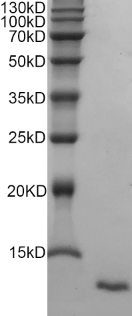| Product name | Rat EGF protein |
| Sequence | Amino acid sequence derived from Rat EGF isoform (P07522)(Asn974-Arg1026) was expressed. |
| Applications | No tag |
| Applications notes | Rat |
| Activity | Measured by its ability to induce proliferation in Balb/3T3 cells. The ED50 for this effect is 0.1098 ng/mL. |
| Protein length | The recombinant Rat EGF consists of 53 amino acids and has a predicted molecular mass of 6.3 kDa. The apparent molecular mass of the Rat EGF protein is approximately 6.3 kDa in SDS-PAGE under reducing conditions . |
| Preparation method | E. coli |
| Purity | ≥ 98 % as determined by SDS-PAGE |
| Formulation | Lyophilized from sterile 20 mM Tris, 50 mM NaCl pH 9.5. |
| Molecular weight | 6.3 kDa |
| Usage notes | Always centrifuge tubes before opening . It is recommended to centrifuge at 12,000 rpm for 1 minute.Then reconstitute the lyophilized Rat EGF protein using the buffer we provided not less than 100µg/ml, which can then be further diluted to other aqueous solutions. |
| Storage instructions | Lyophilized Rat EGF protein product should be stored desiccated below -18°C for 12 months. Upon reconstitution, the protein should be stored at 4°C between 2-7 days and below -18°C for 3 months . For long term storage it is recommended to add a carrier protein (example 0.1% HSA or BSA), aliquot and store below-18°C, Please prevent freeze-thaw cycles. |
| Shipping | Gel pack with blue ice. |
| Precautions | The product listed herein is for research use only and is not intended for use in human or clinical diagnosis. Suggested applications of our products are not recommendations to use our products in violation of any patent or as a license. We cannot be responsible for patent infringements or other violations that may occur with the use of this product. |
| Background | EGF is a single-pass type I membrane protein,containing 8 LDL-receptor class B repeats and 9 EGF-like domains. EGF is a growth factor that stimulates the growth of various epidermal and epithelial tissues in vivo and in vitro and of some fibroblasts in cell culture. It results in cellular proliferation, differentiation, and survival.Additionally, EGF has been shown to inhibit gastric secretion, and to be involved in wound healing. EGF signals through a receptor known as c-erbB, which is a class I tyrosine kinase receptor. This receptor also binds with TGF-α and VGF (vaccinia virus growth factor). |
| Gene ID | 25313 |
| Accession | P07522 |

Fig.SDS-PAGE analysis of Rat EGF protein
You must be logged in to post a review.
Reviews
There are no reviews yet.